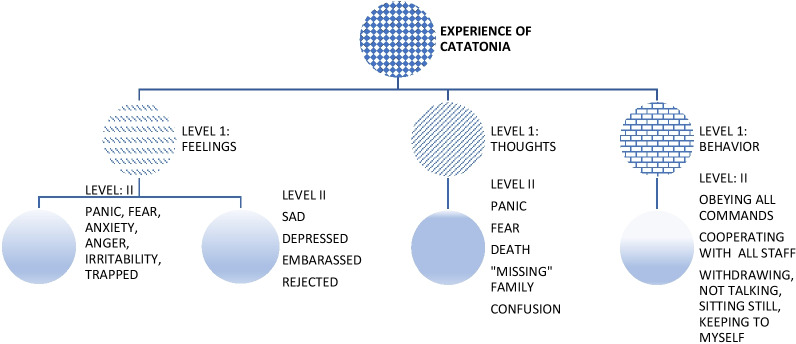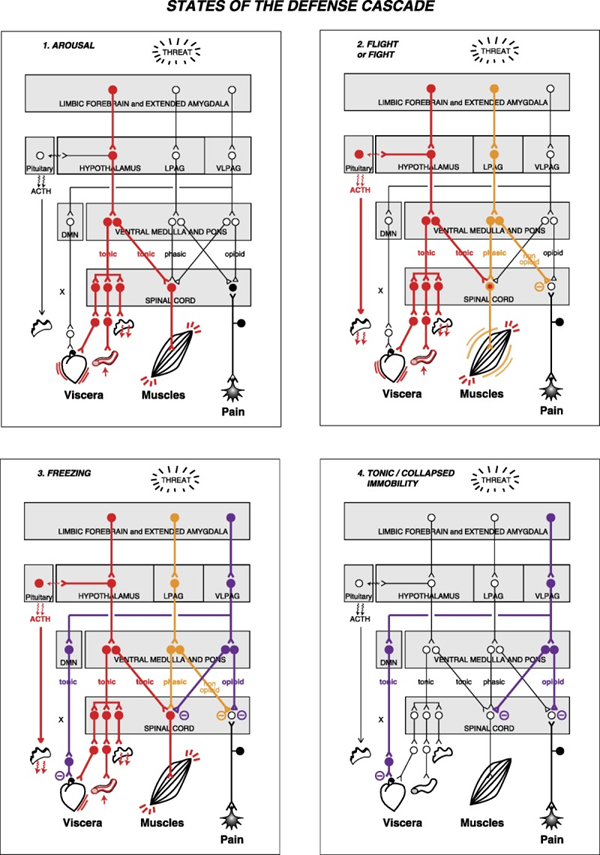We often refer to the stress response as the “Fight or Flight” syndrome, in which we fight the threat or turn and run from it. However, other options exist, including freeze, fright, fawn, or faint.
Essentially, each phase of the stress response represents a defense or survival mechanism.
Freeze:
- A period of hypervigilance in which we “Stop, Look, and Listen” to survey a threat.
- Freezing may occur in response to a social threat or seeing an “angry face.”
- It is possible that “freezing” may even increase our chances of survival by making us less visible to a predator.
- It is characterized by reduced mobility, decreased heart rate, and increased muscle tension and may be considered “flight or fight” put on hold.
Flight:
- At this point, it’s time to escape the threat as quickly as possible.
- The body mobilizes reserves to fuel physical effort and increase blood glucose, blood pressure, and heart rate.
- Stress hormones increase, including epinephrine, norepinephrine, and cortisol.
Fight:
- If we cannot flee, then we may need to fight.
- The body prepares to fight in the same way it prepares to flee.
Fright
- This stage may be characterized by immobility when we see no way out and no way to win a fight once direct contact is made with the threat.
- However, we may still be physically prepared to flee or fight, be hypervigilant, and even experience rapid heart rate.
- Faintness or fainting may occur due to a vasovagal response to a perceived threat and may even be a way of “playing dead” and hoping for another chance to escape.
Fawn
- This is the submissive response which serves to avoid conflict
- It is linked to the same defense system against fear- or anxiety-inducing stimuli
Catatonia (Zingela 2022)
Signs of catatonia, like withdrawal, immobility, and stupor, may be equivalent to
- The freezing aspect of the stress response
- The negativism and combativeness of the fight response
- The automatic and passive obedience to the fawn reaction.

| Summary of emerging themes from subjective descriptions of catatonia |
| Thoughts |
Feelings |
Behaviors |
|
Fear
Yearning (Missing)
Confusion/trying to make sense of things wondering about death
|
Fear/scared/panicked/anxious
Sad and/or anxious
Confused
Trapped
Embarrassed
Rejected
|
Obeying commands
Cooperating with the staff (submission)
Withdrawn/keeping to self
Sitting still
Not talking
|
Source: Zingela, Zukiswa et al. “The psychological and subjective experience of catatonia: a qualitative study.” BMC psychology vol. 10,1 173. 15 Jul. 2022, doi:10.1186/s40359-022-00885-7 This article is licensed under a Creative Commons Attribution 4.0 International License.
States of the defense cascade. The diagram depicts the states of arousal, flight or fight, freezing, and tonic/collapsed immobility in terms of patterns of neural activity in the different structures and pathways of the defense cascade network:

I. Arousal, the first step to the activation of the defense cascade, can be viewed as the activation of the hypothalamus pathway. II. Fight or flight involves the activation of the hypothalamus and lateral periaqueductal gray. III. Freezing—flight or fight put on hold—involves activation of the following: hypothalamus pathway; unmyelinated vagal pathway from the dorsal motor nucleus (which opposes the sympathetic activation); lateral periaqueductal gray; and ventrolateral periaqueductal gray (which opposes activation of the lateral periaqueductal gray). IV. Tonic/collapsed immobility involves activation of the unmyelinated vagal pathway from the dorsal motor nucleus and of the ventrolateral periaqueductal gray pathway. In tonic/collapsed immobility, the hypothalamus pathway is not activated. The filled circles depict activated neurons, whereas the open circles depict non-activated neurons. ACTH, adrenocorticotropic hormone; DMN, dorsal motor nucleus of the vagus; Hyp, hypothalamus; LPAG, lateral periaqueductal gray; VLPAG, ventrolateral periaqueductal gray; X, vagus nerve.
Source: Kozlowska, Kasia et al. “Fear and the Defense Cascade: Clinical Implications and Management.” Harvard review of psychiatry vol. 23,4 (2015): 263-87. doi:10.1097/HRP.0000000000000065 This is an open-access article distributed under the terms of the Creative Commons Attribution-Non Commercial-No Derivatives License 4.0 (CCBY-NC-ND),
Paralyzed by Stress or Fear?
Stress, or our reaction to it, can be paralyzing. However, some simple techniques can help.
Consciously controlling the breath can increase vagal tone, modulate arousal, and improve stress tolerance. Other approaches to managing stress and post-traumatic stress syndrome include:
- Biofeedback
- Cognitive-behavioral therapy (CBT)
- Eye movement desensitization and reprocessing (EMDR)
- Gentle stretching, yoga
- Grounding interventions
- Meditation
- Mindfulness
- Progressive muscle relaxation
- Regular exercise
- Slow, deep, controlled breaths help reverse the stress response
Optimal Takeaways
Identify your stressors, your response to stressors, and your coping mechanisms
-
Fight—this entails facing the danger and fighting the threat aggressively.
-
Flight—this implies running away from the threat to try and save yourself.
-
Freeze—this is equivalent to playing dead through immobility until the threat passes.
-
Fawn—this is the submissive response which serves to avoid conflict.
- Coping—deep breathing, mindfulness, CBT, stretching, yoga, progressive relaxation, regular exercise
References
Bracha, H Stefan. “Freeze, flight, fight, fright, faint: adaptationist perspectives on the acute stress response spectrum.” CNS spectrums vol. 9,9 (2004): 679-85. doi:10.1017/s1092852900001954
Chu, Brianna, et al. “Physiology, Stress Reaction.” StatPearls, StatPearls Publishing, 12 September 2022.
Kozlowska, Kasia et al. “Fear and the Defense Cascade: Clinical Implications and Management.” Harvard review of psychiatry vol. 23,4 (2015): 263-87. doi:10.1097/HRP.0000000000000065 This is an open-access article distributed under the terms of the Creative Commons Attribution-Non Commercial-No Derivatives License 4.0 (CCBY-NC-ND),
Noordewier, Marret K et al. “Freezing in response to social threat: a replication.” Psychological research vol. 84,7 (2020): 1890-1896. doi:10.1007/s00426-019-01203-4
Roelofs, Karin. “Freeze for action: neurobiological mechanisms in animal and human freezing.” Philosophical transactions of the Royal Society of London. Series B, Biological sciences vol. 372,1718 (2017): 20160206. doi:10.1098/rstb.2016.0206
Schmidt, Norman B et al. “Exploring human freeze responses to a threat stressor.” Journal of behavior therapy and experimental psychiatry vol. 39,3 (2008): 292-304. doi:10.1016/j.jbtep.2007.08.002
Zingela, Zukiswa et al. “The psychological and subjective experience of catatonia: a qualitative study.” BMC psychology vol. 10,1 173. 15 Jul. 2022, doi:10.1186/s40359-022-00885-7 This article is licensed under a Creative Commons Attribution 4.0 International License.
Want to Learn More?
CLICK HERE to learn more about Stress, health consequences, biomarkers, etc.

